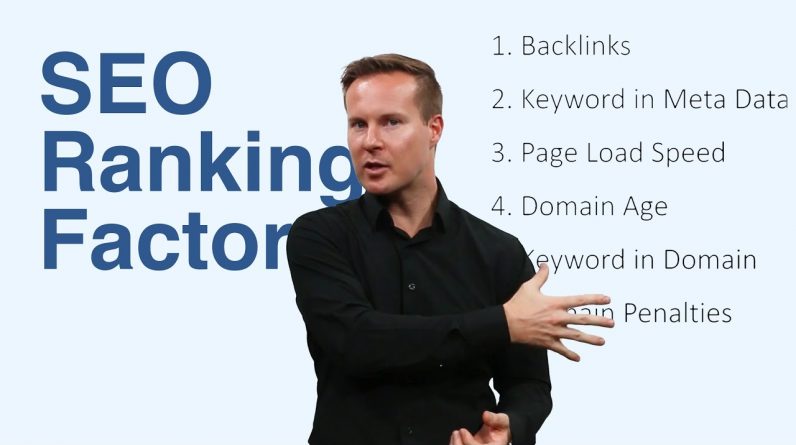
Udemy Course: https://www.udemy.com/course/digital-marketing-101/?referralCode=9CADA367649D12471F66
There are over 200 ranking factors that Google and other search engines use to ranking websites. In this video, we’ll look at the top 10 SEO ranking factors.
The first thing to know is that Google uses bots or spiders to crawl websites. The look at almost every aspect of a website to determine where it should rank.
In my other videos, you can learn about Google Keyword Planner and other tools that will help you determine which keywords your business should use. That’s the first step in SEO. Once you have identified your keywords, you’ll want to watch my other videos to learn how and where to insert them.
But first, let’s look at what Google is looking at on your website.
Domain age refers to the length of time you’ve owned your domain. The longer the better. So if you haven’t purchased your domain yet, you should soon.
Keyword in the top-level domain. If you have a domain with your keyword in the domain, that’s better than not having it in the domain. Better yet, is to have it as the first word.
You have to be careful to not obtain domain penalties. There are a number reasons this could happen. One example of what Black Hat SEO people used to do is put white text on white background on their website in effort to trick Google and visitors to viewing their website. Another example is buying traffic or backlinks. Google is pretty smart and can recognize these types of behaviors, so avoid them at all costs.
You should set your domain to public using your domain registrar. Google prefers transparency.
Make sure to include your Keywords in your Title Tag, Description Tag and H1 Tag. In my other videos, I’ll demonstrate how to edit popular website editors so you can set your Title Tag, Description Tag, and H1 Tag.
It’s almost important to included many keywords in your content and varieties of your keywords. You don’t want to “keyword stuff” your content, instead include keywords and synonyms when relevant—only in a way that aims to help your visitors. By writing enough, it will also increase your content length. While there is no magic amount of words to include on a page, it’s a good idea to provide as much as is necessary to help your visitors.
Backlinks are one of the top ranking factors but the most difficult. You never want to buy backlinks. But you can pay companies to do the outreach for you. And always make sure that your backlinks are on reputable and relevant websites.
Finally, there’s page load speed. This one is the most important. Your page should load within 2 seconds. If it doesn’t, your customers are likely to leave (or bounce, as it’s referred to in Google Analytics).
In this beginner’s course (11 Language Subtitles Available), you’ll learn how to generate more traffic to your businesses’s website, increase your ranking on Google, generate compelling content that will drive interest and sales, create social media posts that people will want to share, and learn how to keep customers coming back. This course is for business owners, entrepreneurs, and working professionals.
After you complete this introductory course, you’ll have the opportunity to dive deeper into each subject in specialized courses in the following areas: Search Engine Optimization (SEO), Email Marketing, Social Media Marketing, Content Marketing, and How to Build a Website.
This is the most popular Digital Marketing course taught in NYC. Since 2014, Steven Matt has taught the material in this course to over 80,000 small business owners in person in downtown Manhattan. Steven has lectured at Baruch University, the General Assembly, and for New York City Business Solutions.
Steven has been helping business owners, entrepreneurs and Fortune 1,000 companies since 1995. As a former business owner and former Vice President of Digital Marketing at JPMorgan Chase, Steven has the experience and insight to help anyone succeed with digital marketing.
Learn from the most influential digital marketer in the industry and transform your business or career today.
I am proud to announce that subtitles are available for 11 languages in my course. In total, my courses have the potential to reach 5.2 billion people worldwide—that’s 65% of the world’s 8 billion population:
English is spoken by 1.2 billion people.
Mandarin Chinese is spoken by 1.1 billion people.
Hindi is spoken by 698 million people in India.
Spanish is spoken by 512 million people.
French is spoken by 284 million people.
Bengali is spoken by 265 million people mostly in Bangladesh and West Bengal.
Russian is spoken by 258 million people.
Portuguese is spoken by 234 million people in Brazil and Portugal.
Indonesian is spoken by 200 million people in Indonesia and some parts of Malaysia.
Urdu is spoken by 170 million people mostly in Pakistan although is also commonly spoken in norther India.
Japanese is spoken by 150 million people.

